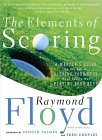The Elements of Scoring: A Master’s Guide to the Art of Scoring Your Best When You’re Not Playing Your Best
Many golfers play the game while their heads are disconnected from reality.
They think they can flop a wedge over a 30-foot bunker to a pin tucked 6 feet from their side of the green. They try to carry a pond with a 2-iron off hardpan.
They whack at a 5-iron through a thick grove of pines, and are surprised when they have to duck the ricochet.
I blame the self-esteem movement.
Self-esteem will not bring a golfer’s handicap down to single digits, and it’s not just a matter of learning how to swing the club. Golfers must know how to score in a game that emphasizes their mistakes.
Raymond Floyd can help golfers learn how to make the best of their talents while out on the course. He’s written a great little book here with Jaime Diaz of Sports Illustrated.
Readers won’t learn how to swing. They will learn how to play.
The book’s subtitle is “A Master’s Guide to the Act of Scoring Your Best When You’re Not Playing Your Best.” That’s among the longer subtitles I’ve seen, but it’s true.
The typical delusion we must all recognize is that simply because we once made a miraculous shot there is no guarantee we can repeat it. Failing to remember this leads to high scores.
Floyd’s book should be an effective antidote. Before he details his extensive tips on scoring from the tee to the green, he first takes the reader through a reality check. The first chapter brought a smile of self-recognition to some of the playing faults he outlined.
See if any of these mistakes sound familiar:
Underclubbing.
Swinging too hard.
Automatically shooting at the flag.
Not playing away from trouble.
Missing the green on the wrong side of the flag.
Trying for too much out of trouble.
Trying shots you have never practiced.
Panicking in the sand.
Misreading turf and lie conditions.
Consistently misreading the break on the greens.
Gently, but directly, Floyd talks about these common mistakes. He then uses the rest of the book to show how to avoid these round-killers and produce lower scores.
The next two chapters are the best: “Knowing Your Game” and “The Universals: What Every Scorer Does.” I often found myself nodding in agreement while reading these two sections.
Throughout this book I felt like I was listening to a really good coach. Floyd won’t tell the readers what they want to hear. He’ll tell them what they need to hear. Just listen, follow his advice, and enjoy the improvement.
The chapters include useful sub-headings that will help the reader find a section to re-read later. It’s a good thing, too, because there’s no index.
The last chapter, “Attitude,” brought a nice close to the book. Floyd shows the wisdom he’s gained in a lifetime of achievement in professional golf. Just read these subheadings and think about them for a little bit:
Enjoy the walk
Be Patient
Respect yourself
Anger
Pressure
Responsibility
Believe what you have to believe
Putting is attitude
Get rid of expectations
Let your attitude get better with age
For anyone who knows Floyd’s personal history, and as he readily admits in this book, the wisdom imparted in this chapter didn’t come easily to him. That makes his recommendations easier to accept.
After reading this book, I could better understand why Fred Couples and other pro golfers respect and appreciate Ray Floyd so much. I’m looking forward to taking his advice.
Review date: March 5, 1999


